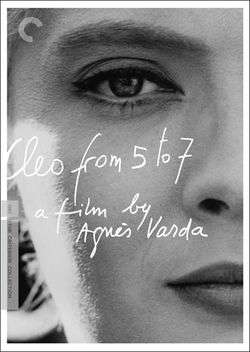Cleo From 5 to 7

"Photographer-turned-director Agnes Varda is considered the archetypal girl who crashed the big boys' clubhouse, and Cléo from 5 to 7 was the film that paid her membership fee."—Slant Magazine, Film review
Cléo From 5 To 7 is one of the first films by Agnes Varda, a Nouvelle Vague director. It depicts two hours in the life of a woman wandering throughout Paris on June 22, 1961.
The film develops several themes: the fear of death, the possibility of living a meaningful life, the relations between human beings, the perception of women. But it is also a quasi-documentary depiction of Paris in the early 1960s.
Tropes used in Cleo From 5 to 7 include:
- Bittersweet Ending: The story ends abruptly without a dramatic resolution, leaving Cléo's fate an open question.
- Brainless Beauty: This is how most people perceive Cléo, and the audience's challenge is to see beyond the stereotype without Cléo herself making it any easier with her flighty, self-absorbed attitude.
- Deliberately Monochrome: The entire film is in black and white, except the opening scene.
- Exactly What It Says on the Tin: There's Cléo, and we're going to be in her company from 5 to 7 p.m.
- Actually, if one wishes to nitpick, the story ends before the two hours are up, which may be meaningful in itself. See Fridge Brilliance below.
- Foreshadowing: The film is peppered with symbolic references to death, such as the words "Deuil" (mourning) and "Pompes funèbres" (funeral parlor) appearing in the background, a mirror breaking and Cléo's black dress.
- Fortune Teller: Her tarot reading at the beginning of the movie is the only scene shot in color. Of course she draws the Death card.
- Gay Paree: Displayed in a naturalistic way. To quote the Slant review again: "Varda captures the fairy-tale essence of early '60s Paris with a vivacity and richness that rivals Godard's Breathless."
- Innocent Fanservice Girl: Cléo's friend is completely unselfconscious about posing nude for a whole room of mostly male sculptors.
- Out-of-Genre Experience: The naturalistic Slice of Life narrative is interspersed in its middle part by a song number.
- Show Within the Show: The movie within the movie.
- Shout-Out: The silent movie is a reference to the films of Buster Keaton. A poster for the surrealist classic Un Chien Andalou is also visible in the background at one point.
- Slice of Life
- Unintentional Period Piece: The film is chock full of footage of Paris crowds and fashion from the 1960s.
- At one point, Cléo, while on a taxi, hears radio news about the Algerian War.
This article is issued from Allthetropes. The text is licensed under Creative Commons - Attribution - Sharealike. Additional terms may apply for the media files.